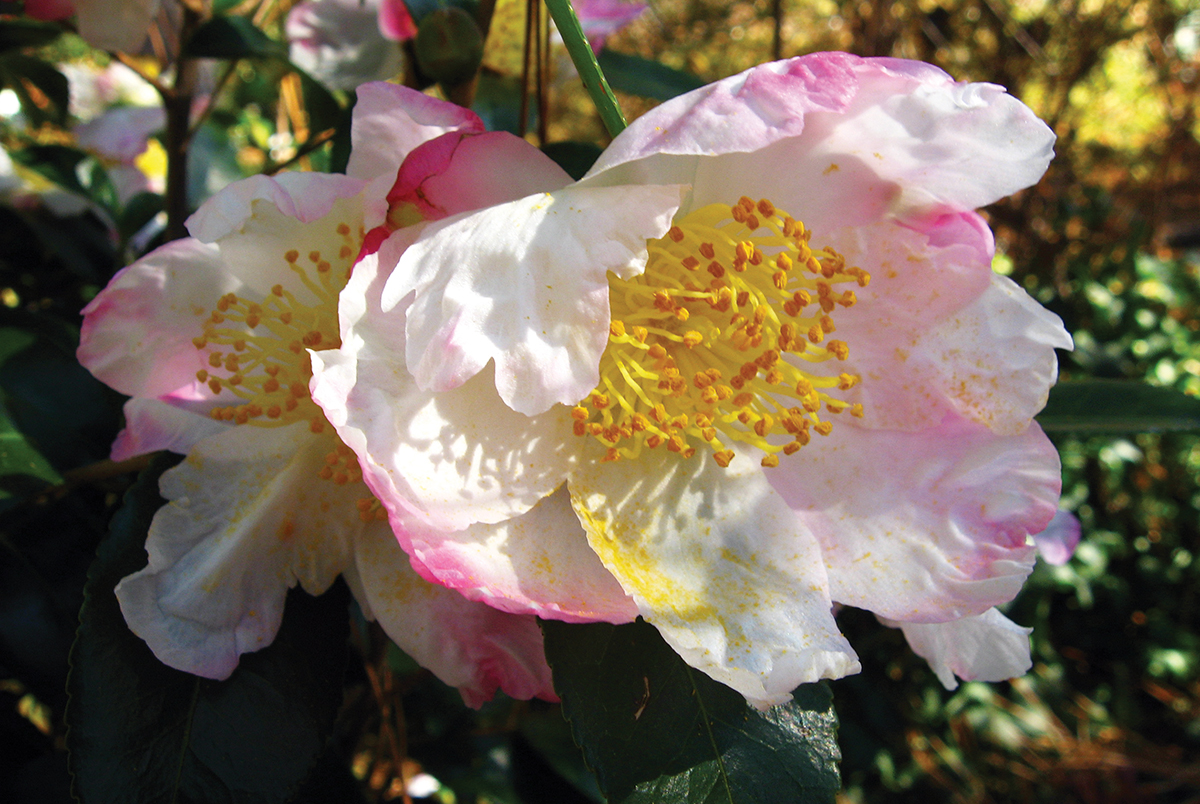The Camellia
Autumn's Jewel

With summer now a memory and cooler temperatures and changing leaves upon us, you may think that color and charm in your garden are also things of the past. But during the time of year when most plants are no longer blooming, don’t fret – camellias are here to save the day.
Stunning and fabulous are two good words to describe camellias. Add easy-to-grow to that list, too. This classic southern plant features incomparable, often pristine flowers either in fall or late winter/early spring and has lustrous evergreen foliage. Flower colors range from sumptuous magenta, deep red, candy pink, smoky ruby, glowing white, and more. They make excellent accent plants, specimens, or low privacy screens. If you’re pondering adding some fall flowers to your landscape, look no further than the fall-blooming sasanqua type camellias and their hybrids. Most will typically grow to about 8-12 feet tall, while dwarf varieties top out around five feet tall. Winter/spring blooming Japanese camellias and hybrid varieties are also offered at nurseries, as well as tea camellias (and, yes, you can grow your own tea). Here are some tips for growing these beautiful plants.
– LIGHT: Camellias are adaptable to a range of light conditions but they mainly prefer morning sun with afternoon shade or bright dappled light all day. Avoid hot, scorching afternoon sun locations for planting, especially those that are windy. Some camellias are more sun tolerant than others, typically the fall-blooming sasanqua types. Those grown in sun usually look a bit sunburned while they are young. Those that tolerate it eventually become accustomed to their site.
– PLANTING: Camellias like well-drained, acid soil with plenty of organic matter. Amend the soil when planting with a pine bark soil conditioner or Permatill, or a mix of the two such as Daddy Pete’s Plant Pleaser Plus Permatill. See the “Planting Guide for Trees & Shrubs” on our website’s “Garden Tips” page for specific directions and diagrams on planting. Never plant camellias so that the base of the trunk is below the soil line and do not permit soil or mulch to wash over the base of the trunk and cover it. Do mulch over the root zone area with your mulch of choice to a depth of 2”-3”.
Camellias are also excellent container plants. Put plants that came in three or five gallon pots into half-barrel or 20”-24” pots. Use a planting mix that is heavy in pine bark fines or make a mix that is 50% regular fluffy potting soil and 50% pine bark soil conditioner. Avoid soil mixes with fertilizer already mixed in.
– WATERING: Camellias need regular water for the first three years in the ground. Young plants can and will die on you if they get too dry. “Regular water” means watering enough to soak the rootball one to two times per week in spring and fall, and two to three times a week in summer for the first year. It’s good to water newbies during late winter dry spells, too. Once established, they can survive on natural rainfall. Old camellias are actually quite drought tolerant.
– FERTILIZING: Fertilize up to three times a year (at least once), but take care not to overfertilize, as this can predispose the plants to winter injury. Use a complete, commercial plant food formulated for “acid-loving plants” such as Holly-tone, and don’t use more than called for on the label. Times to apply: early March, early May, and early July.
– PRUNING: Prune after flowering. You can prune how you like to get the form you want. Cut back the top to make lanky shrubs bushier. Thin out the bottom to create a bare trunk and form a patio tree. Shorten lower branches to promote more upright growth. It’s always a good idea to remove any wood that is dead or weak. If plants become so dense that flowers have no room to open properly, thin the branches to open up the plants.
For more information about camellias, and to find the “Planting Guide for Trees & Shrubs,” please visit www.homewoodnursery.com.
Tina Mast
Communications director at Homewood Nursery in Raleigh.
- info@homewoodnursery.com
- www.homewoodnursery.com
- 919-847-0117

